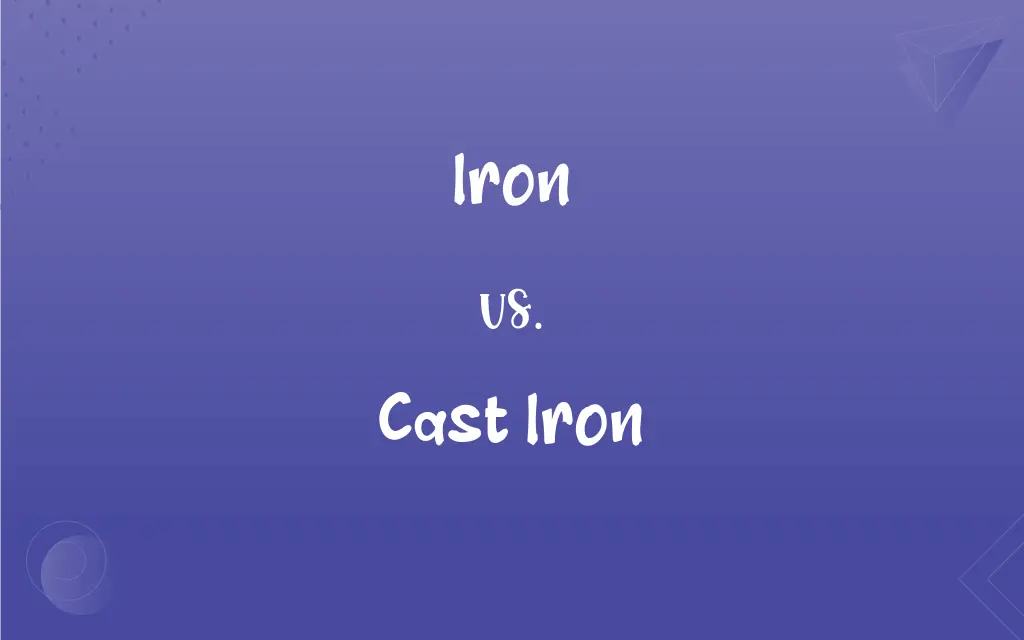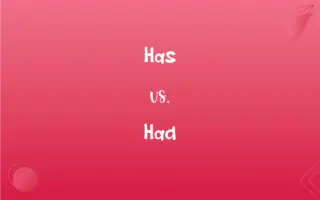Iron vs. Cast Iron: What's the Difference?
Edited by Aimie Carlson || By Janet White || Updated on November 28, 2023
Iron is a chemical element, strong and malleable, while cast iron is an alloy of iron and carbon, known for its durability and brittleness.

Key Differences
Iron is a pure element in the periodic table, known for its strength and malleability, used in various forms in construction and manufacturing. Cast iron, on the other hand, is an alloy primarily made of iron and carbon, characterized by its excellent durability but also its brittleness.
Iron can be found in its pure or nearly pure form and is a key component in steelmaking. While, cast iron involves melting iron and adding a specific amount of carbon, along with other elements, to achieve its distinct properties.
In terms of usage, iron is incredibly versatile, used in everything from building structures to manufacturing tools. However, cast iron is specifically valued in cookware and heavy-duty industrial components due to its heat retention and durability.
Iron can be alloyed with various elements to create different types of steel with varying properties. Cast iron, with its high carbon content, is less malleable than pure iron but excellent for products where weight and durability are paramount.
The physical properties of iron make it ideal for forging and welding. In contrast, cast iron, due to its brittleness, is less suitable for these processes but excels in cast forms where its rigidity and wear resistance are advantageous.
ADVERTISEMENT
Comparison Chart
Composition
Pure element
Alloy (iron + carbon)
Malleability
High
Low (brittle)
Usage
Diverse (construction, manufacturing)
Specific (cookware, industrial parts)
Heat Conductivity
Varies with alloy
Excellent
Suitability for Welding
Good
Limited due to brittleness
ADVERTISEMENT
Iron and Cast Iron Definitions
Iron
The element symbolized as 'Fe' on the periodic table.
Iron is essential in the human diet for oxygen transport in blood.
Cast Iron
Used for making heavy cooking pots and pans.
He cooked the steak in a cast iron skillet.
Iron
A strong, hard magnetic silvery-grey metal.
The bridge was constructed with large iron beams.
Cast Iron
Suitable for manufacturing heavy machinery parts.
The gears were made of durable cast iron.
Iron
Used metaphorically to represent strength or hardness.
Her iron will helped her overcome the challenges.
Cast Iron
A hard, brittle non-malleable iron-carbon alloy.
The old house had ornate cast iron railings.
Iron
An appliance used for smoothing clothes.
She used the iron to press her shirt.
Cast Iron
Often used in decorative architecture and sculptures.
The garden featured a cast iron fountain.
Iron
A hand tool with a flat steel face for striking.
The blacksmith used an iron to shape the horseshoe.
Cast Iron
Known for excellent heat retention and distribution.
Cast iron radiators are efficient for heating rooms.
Iron
Symbol Fe A silvery-white, lustrous, malleable, ductile, magnetic or magnetizable, metallic element occurring abundantly in combined forms, notably in hematite, limonite, magnetite, and taconite, and used alloyed in a wide range of important structural materials. Atomic number 26; atomic weight 55.845; melting point 1,538°C; boiling point 2,861°C; specific gravity 7.874 (at 20°C); valence 2, 3, 4, 6. See Periodic Table.
Cast Iron
Made of cast iron.
Iron
An implement made of iron alloy or similar metal, especially a bar heated for use in branding, curling hair, or cauterizing.
Cast Iron
Rigid; inflexible
A cast-iron rule.
Iron
Great hardness or strength; firmness
A will of iron.
Cast Iron
Exceptionally strong or resistant
A cast-iron stomach.
Cast Iron
Alternative spelling of cast iron
Cast Iron
Alternative spelling of cast iron
Cast Iron
Made of cast iron. Hence, Fig.: like cast iron; hardy; unyielding.
Cast Iron
Extremely robust;
An iron constitution
FAQs
Can both iron and cast iron rust?
Yes, both can rust but cast iron is more prone to rusting.
Can cast iron be as malleable as iron?
No, cast iron is more brittle and less malleable than iron.
Is cast iron heavier than iron?
Generally, cast iron is denser and thus can be heavier.
Is iron used in making cast iron?
Yes, iron is the primary component in cast iron.
What is the primary difference between iron and cast iron?
Iron is a pure element, while cast iron is an alloy with added carbon.
Are there different types of iron and cast iron?
Yes, both come in various forms depending on their composition and treatment.
Is welding cast iron more challenging than iron?
Yes, due to its brittleness, cast iron is harder to weld.
Do iron and cast iron have different heat conductivities?
Yes, cast iron has better heat retention and distribution.
Are there health benefits to cooking with cast iron?
Yes, cooking with cast iron can increase iron intake.
Can cast iron be used for outdoor structures?
Yes, but it needs protection from the elements to prevent rust.
Can cast iron be as finely shaped as iron?
No, cast iron is not suitable for fine shaping due to its brittleness.
How do you maintain cast iron cookware?
Regular seasoning and avoiding soap preserves its quality.
Can iron and cast iron be used interchangeably?
No, their properties make them suitable for different applications.
Is cast iron good for cooking?
Yes, it's excellent for cookware due to its heat retention.
Can iron be as durable as cast iron?
Iron is durable, but cast iron is often more durable in certain applications.
Is iron more versatile than cast iron?
Yes, iron is more versatile due to its malleability and range of applications.
Are both iron and cast iron recyclable?
Yes, both can be recycled.
Does cast iron break more easily than iron?
Yes, its brittleness makes it more prone to cracking under stress.
Is cast iron more expensive than iron?
The cost varies, but generally, cast iron products can be more expensive.
Are there environmental impacts of producing iron and cast iron?
Yes, both have environmental impacts, especially in terms of energy use and emissions.
About Author
Written by
Janet WhiteJanet White has been an esteemed writer and blogger for Difference Wiki. Holding a Master's degree in Science and Medical Journalism from the prestigious Boston University, she has consistently demonstrated her expertise and passion for her field. When she's not immersed in her work, Janet relishes her time exercising, delving into a good book, and cherishing moments with friends and family.
Edited by
Aimie CarlsonAimie Carlson, holding a master's degree in English literature, is a fervent English language enthusiast. She lends her writing talents to Difference Wiki, a prominent website that specializes in comparisons, offering readers insightful analyses that both captivate and inform.































































